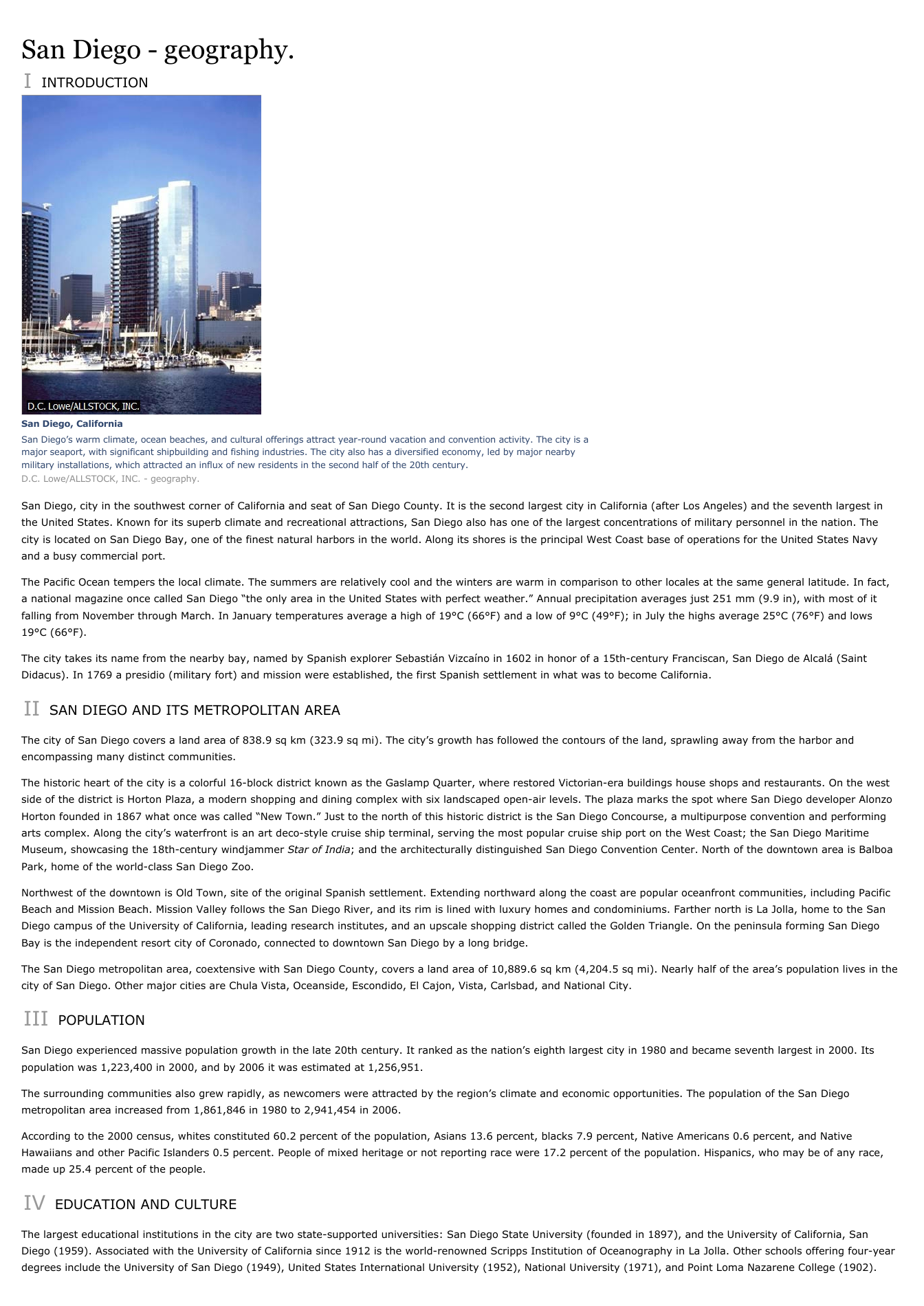San Diego - geography.
Publié le 18/05/2020
Extrait du document
«
San Diego - geography.
IINTRODUCTION
San Diego, CaliforniaSan Diego’s warm climate, ocean beaches, and cultural offerings attract year-round vacation and convention activity.
The city is amajor seaport, with significant shipbuilding and fishing industries.
The city also has a diversified economy, led by major nearbymilitary installations, which attracted an influx of new residents in the second half of the 20th century.D.C.
Lowe/ALLSTOCK, INC.
- geography.
San Diego , city in the southwest corner of California and seat of San Diego County.
It is the second largest city in California (after Los Angeles) and the seventh largest in the United States.
Known for its superb climate and recreational attractions, San Diego also has one of the largest concentrations of military personnel in the nation.
Thecity is located on San Diego Bay, one of the finest natural harbors in the world.
Along its shores is the principal West Coast base of operations for the United States Navyand a busy commercial port.
The Pacific Ocean tempers the local climate.
The summers are relatively cool and the winters are warm in comparison to other locales at the same general latitude.
In fact,a national magazine once called San Diego “the only area in the United States with perfect weather.” Annual precipitation averages just 251 mm (9.9 in), with most of itfalling from November through March.
In January temperatures average a high of 19°C (66°F) and a low of 9°C (49°F); in July the highs average 25°C (76°F) and lows19°C (66°F).
The city takes its name from the nearby bay, named by Spanish explorer Sebastián Vizcaíno in 1602 in honor of a 15th-century Franciscan, San Diego de Alcalá (SaintDidacus).
In 1769 a presidio (military fort) and mission were established, the first Spanish settlement in what was to become California.
II SAN DIEGO AND ITS METROPOLITAN AREA
The city of San Diego covers a land area of 838.9 sq km (323.9 sq mi).
The city’s growth has followed the contours of the land, sprawling away from the harbor andencompassing many distinct communities.
The historic heart of the city is a colorful 16-block district known as the Gaslamp Quarter, where restored Victorian-era buildings house shops and restaurants.
On the westside of the district is Horton Plaza, a modern shopping and dining complex with six landscaped open-air levels.
The plaza marks the spot where San Diego developer AlonzoHorton founded in 1867 what once was called “New Town.” Just to the north of this historic district is the San Diego Concourse, a multipurpose convention and performingarts complex.
Along the city’s waterfront is an art deco-style cruise ship terminal, serving the most popular cruise ship port on the West Coast; the San Diego MaritimeMuseum, showcasing the 18th-century windjammer Star of India ; and the architecturally distinguished San Diego Convention Center.
North of the downtown area is Balboa Park, home of the world-class San Diego Zoo.
Northwest of the downtown is Old Town, site of the original Spanish settlement.
Extending northward along the coast are popular oceanfront communities, including PacificBeach and Mission Beach.
Mission Valley follows the San Diego River, and its rim is lined with luxury homes and condominiums.
Farther north is La Jolla, home to the SanDiego campus of the University of California, leading research institutes, and an upscale shopping district called the Golden Triangle.
On the peninsula forming San DiegoBay is the independent resort city of Coronado, connected to downtown San Diego by a long bridge.
The San Diego metropolitan area, coextensive with San Diego County, covers a land area of 10,889.6 sq km (4,204.5 sq mi).
Nearly half of the area’s population lives in thecity of San Diego.
Other major cities are Chula Vista, Oceanside, Escondido, El Cajon, Vista, Carlsbad, and National City.
III POPULATION
San Diego experienced massive population growth in the late 20th century.
It ranked as the nation’s eighth largest city in 1980 and became seventh largest in 2000.
Itspopulation was 1,223,400 in 2000, and by 2006 it was estimated at 1,256,951.
The surrounding communities also grew rapidly, as newcomers were attracted by the region’s climate and economic opportunities.
The population of the San Diegometropolitan area increased from 1,861,846 in 1980 to 2,941,454 in 2006.
According to the 2000 census, whites constituted 60.2 percent of the population, Asians 13.6 percent, blacks 7.9 percent, Native Americans 0.6 percent, and NativeHawaiians and other Pacific Islanders 0.5 percent.
People of mixed heritage or not reporting race were 17.2 percent of the population.
Hispanics, who may be of any race,made up 25.4 percent of the people.
IV EDUCATION AND CULTURE
The largest educational institutions in the city are two state-supported universities: San Diego State University (founded in 1897), and the University of California, SanDiego (1959).
Associated with the University of California since 1912 is the world-renowned Scripps Institution of Oceanography in La Jolla.
Other schools offering four-yeardegrees include the University of San Diego (1949), United States International University (1952), National University (1971), and Point Loma Nazarene College (1902)..
»
↓↓↓ APERÇU DU DOCUMENT ↓↓↓

































